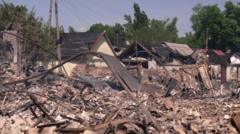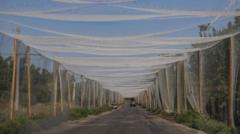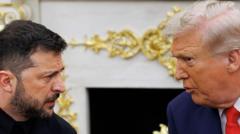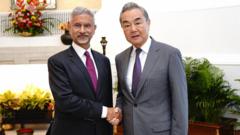As the conflict in Ukraine continues to evolve, the introduction of advanced drone technology is altering the landscape of battle. In cities like Rodynske, the haunting sounds of drone warfare have replaced traditional combat sounds, with civilians and soldiers alike feeling the strain of this new tactic.
**The Evolving Battlefield: How Drones Are Reshaping the Ukrainian Conflict**

**The Evolving Battlefield: How Drones Are Reshaping the Ukrainian Conflict**
New drone technology is altering combat dynamics in Ukraine as Russia intensifies its attacks, creating new challenges for Ukrainian forces.
The town of Rodynske is under siege from Russian forces, with recent drone attacks devastating its infrastructure. A 250kg glide bomb has wrecked the main administrative building and destroyed residential blocks, as the tactics of the war take a darker turn. Close combat is now accompanied by the looming threat of drones overhead, primarily used by Russian forces to cut off key supply routes and target Ukrainian positions.
The shift to deploying fibre optic drones presents a substantial challenge for Ukrainian soldiers. Designed to transmit video and control signals through a physical cable rather than radio frequencies, these drones are resistant to electronic jamming efforts, making them a formidable asset in the current warfare landscape. As these drones increase in usage, the safety and effectiveness of Ukrainian forces are jeopardized. Soldiers report longer assignments to frontline positions and heightened anxiety regarding potential drone detection, ultimately reshaping their operational strategies.
While Russia has the lead in drone technology, Ukraine is striving to keep pace. Soldiers like Serhii recount their struggles against the relentless drone assaults, knowing they must adapt to survive. This ongoing race for technological superiority on the battlefield mirrors the emotional toll on the soldiers stationed out in the field, who are separated from family and loved ones for prolonged periods.
As the war stretches into its fourth summer, both sides face their battles not just in soldier headcount, but in the rapid advancement and deployment of military technology. The Ukrainian forces remain resilient, but the war's intensity and the evolving threats present grave considerations for their future maneuvers.
In a conflict marked by both innovation and desperation, the impact of changing warfare tactics continues to unfold—a stark reminder of the grim reality facing both combatants and civilians in Ukraine.
The shift to deploying fibre optic drones presents a substantial challenge for Ukrainian soldiers. Designed to transmit video and control signals through a physical cable rather than radio frequencies, these drones are resistant to electronic jamming efforts, making them a formidable asset in the current warfare landscape. As these drones increase in usage, the safety and effectiveness of Ukrainian forces are jeopardized. Soldiers report longer assignments to frontline positions and heightened anxiety regarding potential drone detection, ultimately reshaping their operational strategies.
While Russia has the lead in drone technology, Ukraine is striving to keep pace. Soldiers like Serhii recount their struggles against the relentless drone assaults, knowing they must adapt to survive. This ongoing race for technological superiority on the battlefield mirrors the emotional toll on the soldiers stationed out in the field, who are separated from family and loved ones for prolonged periods.
As the war stretches into its fourth summer, both sides face their battles not just in soldier headcount, but in the rapid advancement and deployment of military technology. The Ukrainian forces remain resilient, but the war's intensity and the evolving threats present grave considerations for their future maneuvers.
In a conflict marked by both innovation and desperation, the impact of changing warfare tactics continues to unfold—a stark reminder of the grim reality facing both combatants and civilians in Ukraine.


















